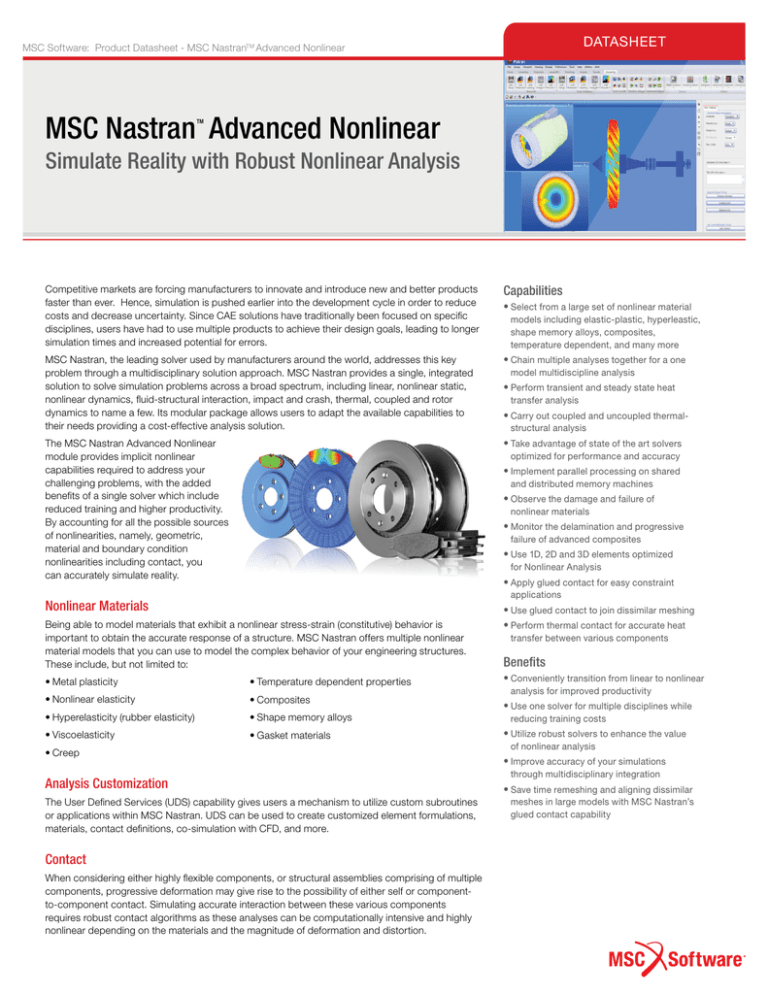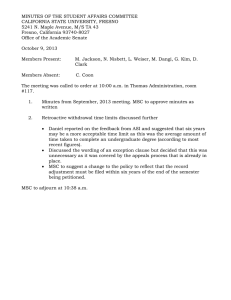
DATASHEET
MSC Software: Product Datasheet - MSC NastranTM Advanced Nonlinear
MSC Nastran Advanced Nonlinear
TM
Simulate Reality with Robust Nonlinear Analysis
Competitive markets are forcing manufacturers to innovate and introduce new and better products
faster than ever. Hence, simulation is pushed earlier into the development cycle in order to reduce
costs and decrease uncertainty. Since CAE solutions have traditionally been focused on specific
disciplines, users have had to use multiple products to achieve their design goals, leading to longer
simulation times and increased potential for errors.
Capabilities
MSC Nastran, the leading solver used by manufacturers around the world, addresses this key
problem through a multidisciplinary solution approach. MSC Nastran provides a single, integrated
solution to solve simulation problems across a broad spectrum, including linear, nonlinear static,
nonlinear dynamics, fluid-structural interaction, impact and crash, thermal, coupled and rotor
dynamics to name a few. Its modular package allows users to adapt the available capabilities to
their needs providing a cost-effective analysis solution.
•Chain multiple analyses together for a one
The MSC Nastran Advanced Nonlinear
module provides implicit nonlinear
capabilities required to address your
challenging problems, with the added
benefits of a single solver which include
reduced training and higher productivity.
By accounting for all the possible sources
of nonlinearities, namely, geometric,
material and boundary condition
nonlinearities including contact, you
can accurately simulate reality.
•Take advantage of state of the art solvers
models including elastic-plastic, hyperleastic,
shape memory alloys, composites,
temperature dependent, and many more
model multidiscipline analysis
•Perform transient and steady state heat
transfer analysis
•Carry out coupled and uncoupled thermalstructural analysis
optimized for performance and accuracy
•Implement parallel processing on shared
and distributed memory machines
•Observe the damage and failure of
nonlinear materials
•Monitor the delamination and progressive
failure of advanced composites
•Use 1D, 2D and 3D elements optimized
for Nonlinear Analysis
•Apply glued contact for easy constraint
applications
Nonlinear Materials
Being able to model materials that exhibit a nonlinear stress-strain (constitutive) behavior is
important to obtain the accurate response of a structure. MSC Nastran offers multiple nonlinear
material models that you can use to model the complex behavior of your engineering structures.
These include, but not limited to:
•Metal plasticity
•Temperature dependent properties
•Nonlinear elasticity
•Composites
•Hyperelasticity (rubber elasticity)
•Shape memory alloys
•Viscoelasticity
•Select from a large set of nonlinear material
•Gasket materials
•Creep
Analysis Customization
The User Defined Services (UDS) capability gives users a mechanism to utilize custom subroutines
or applications within MSC Nastran. UDS can be used to create customized element formulations,
materials, contact definitions, co-simulation with CFD, and more.
Contact
When considering either highly flexible components, or structural assemblies comprising of multiple
components, progressive deformation may give rise to the possibility of either self or componentto-component contact. Simulating accurate interaction between these various components
requires robust contact algorithms as these analyses can be computationally intensive and highly
nonlinear depending on the materials and the magnitude of deformation and distortion.
•Use glued contact to join dissimilar meshing
•Perform thermal contact for accurate heat
transfer between various components
Benefits
•Conveniently transition from linear to nonlinear
analysis for improved productivity
•Use one solver for multiple disciplines while
reducing training costs
•Utilize robust solvers to enhance the value
of nonlinear analysis
•Improve accuracy of your simulations
through multidisciplinary integration
•Save time remeshing and aligning dissimilar
meshes in large models with MSC Nastran’s
glued contact capability
DATASHEET
MSC Software: Product Datasheet - MSC NastranTM Advanced Nonlinear
MSC Nastran provides superior contact solution through its unique
functionality:
•Intuitive, easy to set up without the need for prior
knowledge of contact regions
•Faster pre-processing, with automatic detection of contact boundary
•Improved accuracy through the use of NURBS for analytical
contact for rigid body definition
•Material properties that can be temperature dependent
•Choice of elements, including shell, solid shell and solid (continuum)
elements best suited for your applications
•Multiple composite failure criteria to choose from, including
maximum stress, maximum strain, Hill, Hoffman, Tsai-Wu,
Hashin, Puck, Hashin-Tape, or Hashin-Fabric
•Reduced effort with no need to mesh rigid bodies
•Progressive Failure Analysis of composite material to analyze
structural behavior after complete material degradation
•State of the art segment-to-segment contact detection
for improved accuracy
•Virtual Crack Closure Technique for crack growth resistance
and crack propagation studies
•Support for 1D, 2D and 3D elements for improved flexibility
•Interface elements using a cohesive zone model for delamination
analysis, applicable to both homogeneous and composite structures
•Moment transfer between continuum elements and shells
and beams for improved accuracy and easier modeling
•For assembly modeling, define numerous contact interactions with ease
through the use of contact pairs
Chained Analysis
Structures are often subjected to loads that span multiple disciplines and
for improved accuracy, it is critical to account for all these disciplines.
In solvers focused on single discipline efficiency, the chaining between
multiple disciplines can be inefficient and cumbersome.
With MSC Nastran, users can model the effects of the various disciplines.
Some examples include:
•Perturbation analysis to perform a linear analysis based on the
nonlinear equilibrium state of a structure
Thermal Analysis and Thermal-Structural Coupling
Thermal analysis is only second to structural analysis in terms of its
usage because of the need to account for temperature variations
on structural performance. MSC Nastran provides a complete set
of capabilities to solve your thermal problems including a number of
nonlinear and temperature dependent properties. The thermal variations
often affect structural response and vice versa requiring a coupled
analysis for better understanding of the physics. For example, friction
in brake systems generates heat and the temperature gradients may
lead to warping which in turn could be the source of unwanted noise.
MSC Nastran helps you simulate multiple physics in a single model
giving engineers ability to simultaneously simulate the interaction of
structural and thermal loads.
•Multiple options for perturbation analysis, including linear statics,
normal modes, buckling, direct and modal frequency response,
direct and modal complex Eigenvalues, modal transient response,
static aeroelastic response, and aerodynamic flutter
•Thermal analysis accounting for all modes of heat transfer
(conduction, convection and radiation)
•Chained thermal-structural analysis (thermal analysis followed
by a separate stress analysis)
•Temperature dependent material properties for improved accuracy
•Efficient calculation of radiation view factors for higher productivity
•Steady state and transient heat transfer analysis
•Linear and nonlinear material properties for better representation
of behavior
•Thermal contact to allow heat transfer across components
•Perform thermal stress analysis with temperatures as initial conditions
•Coupling of thermal and structural behaviors
•Inclusion of friction and internal plastic heat generation
Performance
With increased use of simulation, both the model size and the number
of simulations are on the rise. However, tighter time constraints would
mean that these analyses need to be run faster. To address this challenge,
MSC Nastran continues to prove its leadership in High Performance
Computing (HPC) by addressing the issue on multiple fronts.
Composites - Stress and Failure Analysis
Designing and testing of composite structures is expensive and time
consuming. MSC Nastran makes it easy to model and analyze composite
materials helping you analyze the stress/strain response of each ply in
a laminate and also understand the failure behavior of the structure.
The tools offered are ideal for any of the common types of composites,
including polymer matrix, metal matrix, ceramic matrix, carbon matrix and
more. In addition, the ability to quantify damage and predict failure helps
improve safety of your composite products.
•Faster, efficient direct and iterative sparse solvers
•Efficient use of system resources,
including GPU devices for additional
floating point computing power
•Parallel solvers that can provide you with
faster solution times on both distributed
and shared-memory systems
•Stress analysis of any possible lay-up configuration for either linear
or nonlinear response
Corporate
MSC Software Corporation
4675 MacArthur Court
Suite 900
Newport Beach, CA 92660
Telephone 714.540.8900
www.mscsoftware.com
Europe, Middle East,
Africa
MSC Software GmbH
Am Moosfeld 13
81829 Munich, Germany
Telephone 49.89.431.98.70
Asia-Pacific
MSC Software Japan LTD.
Shinjuku First West 8F
23-7 Nishi Shinjuku
1-Chome, Shinjuku-Ku
Tokyo, Japan 160-0023
Telephone 81.3.6911.1200
Asia-Pacific
MSC Software (S) Pte. Ltd.
100 Beach Road
#16-05 Shaw Towers
Singapore 189702
Telephone 65.6272.0082
The MSC Software corporate logo, MSC, and the names of the
MSC Software products and services referenced herein are trademarks
or registered trademarks of the MSC.Software Corporation in the United
States and/or other countries. All other trademarks belong to their
respective owners. © 2013 MSC.Software Corporation. All rights reserved.
MNAL*2013SEPT*DS





